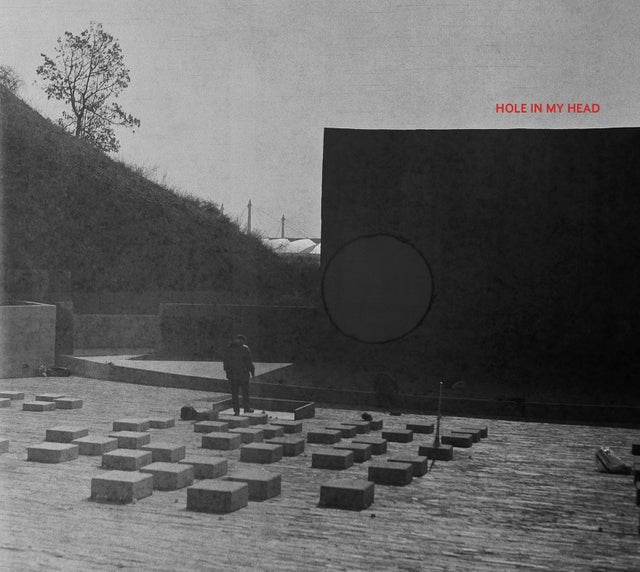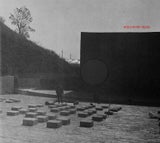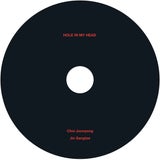Choi Joonyong/Jin Sangtae - Hole In My Head (CD)
SKU:
$14.00
$14.00
Unavailable
per item
Erstwhile 089
Recording in two locations in Seoul by Taku Unami, electronic, sound and noise artists Choi Joonyong and Jin Sangtae present a series of unusual interactions using sonic events, concrete and acousmatic interjections and aberrant expression, patiently conveying each event with clarity and intention and an almost theatrical sense of drama and narrative.
For lossless (16/44) files, go to this page.
|
TRACK LIST
1. H (01:35) 2. E (08:21) 3. A (05:59) 4. D (06:04) 5. in my (06:32) 6. H (11:45) 7. O (04:42) 8. L (02:53) 9. E (08:23) (released November 5, 2020) CREDITS
Choi Joonyong/Jin Sangtae - Hole In My Head (erstwhile 089) music by Choi Joonyong and Jin Sangtae recorded by Taku Unami at: T2 Stage, Oil Tank Culture Park, Seoul, Korea, February 7 and 10, 2020 dotolim, Seoul, Korea, February 9, 2020 mixed by Choi Joonyong and Jin Sangtae mastered and photography by Taku Unami design by Yuko Zama produced by Jon Abbey special thanks to Won-gyeom Choe |
REVIEWS
Marc Medwin, Dusted Ping-pong and drumsticks and rocks, oh my! Pitch-and-sound pods burst, vanish or simply seep into one another, errant music molecules colliding, bullying their ways to prominence. No stone is left unexamined and many are hurled, creating a universe more inclusive, jarring and whimsically immersive than any L. Frank Baum or the good folks at MGM imagined as Hole in my Head sweeps and bludgeons its way toward the denouement that never quite arrives. While the two Korean firebrands usually have no compunction about inflicting a kind of high-energy sonic torture, this often dreamy effort actually lowers their usual confrontation dynamic, but ear fatigue may still be a factor. Caution is recommended during the high-frequency sweep-kicks opening the first “E” or the polyrhythmic jackhammer, hyper-abrasive cutlery manipulation, electro-rumble and piercing industro-squeak of “A.” Those delicately brutal moments have their complement in the second “H” as it lurches and squalls its way into existence. Throughout, a heightened, almost multidimensional, awareness of natural and obviously manipulated sound sources asserts itself; that juxtaposition establishes a parallel, or is it a binary, even if fluid, revisited as the music sprints forward or simply buys time. The album begins conventionally enough, in medias res, with something even resembling an overture. To test an environment’s sonic characteristics, a handclap will often do the trick, and that’s what delineates the obviously external world into which we’re initially and unceremoniously dropped. Headphones reveal what has to be a binaural recording process throughout the disc as the clap moves even further off-center, echoing way out in front and finally coming back with a Gargantuan and naturally reverberant swing to the right. Meanwhile to all that, as twigs, birds and breeze, with a lusciously captured traffic backdrop, simply exist in stunningly natural detail, someone walks close enough to my face to induce a moment of paranoia. The explosive clap nearly overpowers everything else before the sudden track switch necessitates environmental readjustment, introducing the other sonic elements revisited at various strategic points as things fall and roll with delicious precision. The juxtapositions are absolutely irresistible! Like those tones and timbres that threaten to shred ears and speakers, they rip holes in time or in the demarcations supposedly partitioning it. “In My” boasts some gorgeously retro drum sounds that make the crow stage right sound like some kind of techno-pop throwback as the ping-pong balls keep raining. It’s all sort of like Bladerunner without the angst. In fact, a C-major organ chord directly, dangerously, in the path of some metallic clatter is downright amusing. If there is a climax, it might be the grinding mind-stomp centerstage in the final piece, but it’s momentary and not really a climax in any traditional sense; we’ve heard it all before. It evaporates, leaving something eerily close to the overture, a drum-stick pairing replacing the clapping, a few stray ping-pong balls rustling gently at close range. Parsing the events in this way says nothing of their impact, their jocoserious jostle and joust. Even to label the collaboration as a golden-mean exploration of old and new, or of the willfully snarky interplay of black-and-white monochromaticism with the kaleidoscope of three-dimensional space would be to downplay its visceral impact. It speaks to the label’s evolution. Erstwhile is more and more in the habit of dropping slices of warped and fused reality, and this is certainly one. It embraces the rapid-fire Musique Concret of an old friend like eRikm and dieb13’s Chaos Club, but the aesthetic has now been assimilated, moving beyond syntax to the point of metanarrative. Order and disorder aren’t nearly as important as the hazy boundary never quite separating them, just as Hole in my Head’s story ultimately ends up without a plot. Like that hole, reality is admitted, filtered and playfully discarded with each careening object. As Kerouac so eloquently puts it: “Stretch that skull-cover and smile.” Michele Palozzo, esoteros The only true non-places are those of the mind: but being able to give them a tangible form doesn’t always equate to the delineation of a balanced, pictorially satisfying landscape, nor does it solve the inner mystery from which it originated. In the creation of an audio document, even the simplest sonic occurrence derives from an idea and a gesture, even if only pressing the record button: and it’s precisely the gesture – be it overt, dissimulated, concealed, or mediated – the absolute protagonist of the free exploration conducted by South Korean sound artists Choi Joonyong and Jin Sangtae in their latest collaboration under the aegis of Erstwhile Records, after twenty years of activity still firmly presiding over the territories of the most radical expressive otherness. Unlike many free impro sessions, in the credits for Hole in My Head the objects and instruments used by the two artists are not specified, while to them is more generally attributed the ‘music’ of the album, recorded by Taku Unami between February 7 and 10 of this year at two cultural venues in Seoul (the Dotolim space and the Oil Tank Culture Park). But although these sessions can easily fall within the field of an alleged non-music – that is, foreign to a more or less canonical “playing” –, it’s suprising how the duo manages to create a compelling dramaturgy based almost exclusively on the juxtaposition of concrete sounds produced live in variable relationship with the surrounding space, here and there crossed or surmounted by alienating collages and electronic incursions. For the purposes of individual listening, the acousmatic quality of the sonic instances involved remains essential: in the larger picture of the work, in fact, even recognizable phenomena such as a handclap, or a ping pong ball bouncing on the ground, comply with the process of abstraction through which Joonyong and Sangtae give equal dignity and depth to each discrete element. Industrial clangours and para-rhythmic interventions on heterogeneous materials, minute glitchy punctuations and obtundent noise saturations become the indistinct traces of their passage, non-significant in the same way, a shapeless theme of the urban periphery and a counterpoint to the natural resonances and the birdsong that occasionally repopulates the gloomy open-air views. Despite the emotional detachment and the objectifying yearning typical of the Far Eastern experimental scene, the spectre of anthropic abuse of the landscape, albeit involuntarily, seems to make its way through the folds of Hole in My Head, a sense of bitter artificiality that persists precisely because of the context in which the sound gestures are forcibly inscribed, among the concrete barriers that identify and delimit the ever-expanding domain of modern civilization. If Toshiya Tsunoda’s field recording archive captured the invisible changes in the port ecosystem through the detail of strategic microphonations, Choi Joonyong and Jin Sangtae exhibit the violence – sometimes quiet, other times brutal – of a senseless and insatiable human action, the apparently reassuring facade of a decay of which, sooner or later, we ourselves will be the ones to pay the price. |



